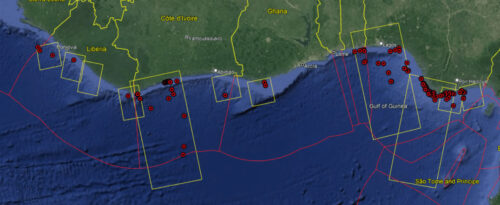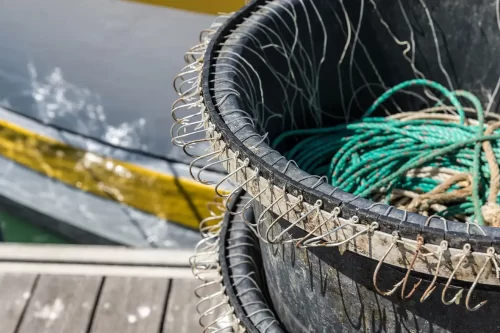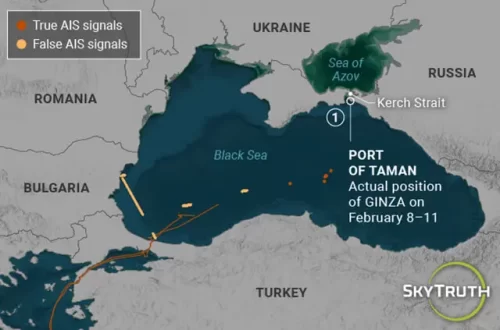This year’s first fishing season for Peruvian anchovy opens on May 4th and for the first time ever anyone can track the fishing fleet as the season progresses, thanks to the recent agreement to publish Peru’s vessel data via Global Fishing Watch’s public map. En español
Monitoring of the Peruvian anchovy fleet using the national Vessel Tracking System (VMS) was previously accessed only by Peruvian government agencies – the Ministry of Production and the Peruvian Sea Institute, and some representatives of the fishing industry. With the first opening this week of the 2019 anchovy fishing season, anyone interested in the fishery – from researchers and fishers to journalists and NGOs – can now observe and track each vessel in the entire Peruvian anchovy fleet, the world’s largest fishery by volume. The fleet represents some 850 vessels and is expected to catch just over 2 million tons of anchovy, largely destined for use in fishmeal and oil.
Fishing effort using only AIS data (left) and fishing effort combining data from AIS and VMS in Peru (right). Move the slider bar across the image.
A tiny fish with a big impact
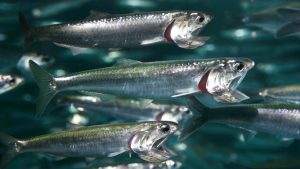 The Peruvian anchovy (Engraulis ringens) is a small fish that lives in the southeast Pacific Ocean, primarily off the coasts of Chile and Peru. It lives in the productive waters of upwelling zones, where deep nutrient-rich seawater is brought to the surface by the prevalent currents. Peruvian anchovy feed in these zones and form massive schools that may be several kilometers across. These schools are heavily exploited by commercial fisheries, making the Peruvian anchovy the largest fishery, by both numbers of individuals and by weight. This fishery supports a processing industry that makes Peru the world’s leading producer of fishmeal.
The Peruvian anchovy (Engraulis ringens) is a small fish that lives in the southeast Pacific Ocean, primarily off the coasts of Chile and Peru. It lives in the productive waters of upwelling zones, where deep nutrient-rich seawater is brought to the surface by the prevalent currents. Peruvian anchovy feed in these zones and form massive schools that may be several kilometers across. These schools are heavily exploited by commercial fisheries, making the Peruvian anchovy the largest fishery, by both numbers of individuals and by weight. This fishery supports a processing industry that makes Peru the world’s leading producer of fishmeal.
A major step forward in monitoring fishing
In October 2018, Peru made its satellite tracking data for vessels available for the first time through Global Fishing Watch. The vessel tracking data available through the Global Fishing Watch map includes near-real time data and vessel information dating back to 2012. A fishing fleet of approximately 1400 vessels, including purse seiners, trawlers, longliners, and gillnetters, can now be monitored freely through the platform
More than half of the vessel tracking data from Peru tracks vessels in the anchovy fishery. By sharing its VMS data with Global Fishing Watch, Peru has demonstrated great leadership in data transparency, now making it possible for anyone to follow a Peruvian anchovy vessel from port back to fishing grounds.
All eyes on anchovy
Peru’s VMS data is very high resolution with vessels transmitting their position every 10 minutes. An anchovy fishing operation lasts an average of 2 hours which corresponds to up to 12 VMS positions that can be used to identify the fishing operation. The start and end of these operations is usually clear from the vessel track and Global Fishing Watch uses machine learning to automatically detect when fishing likely occurred.
It is also possible to follow the operation when a single vessel, or pair of vessels, are fishing together. An example of this from the 2018 season is the encounter between the anchovy vessels NUEVA OFELITA and KIANA. Both belong to the same business group, AUSTRAL GROUP SAA, and shared the same fishing area for 2 hours, as shown by the Global Fishing Watch map. These vessels likely came together so that one of the vessels could transfer excess catch to the other.
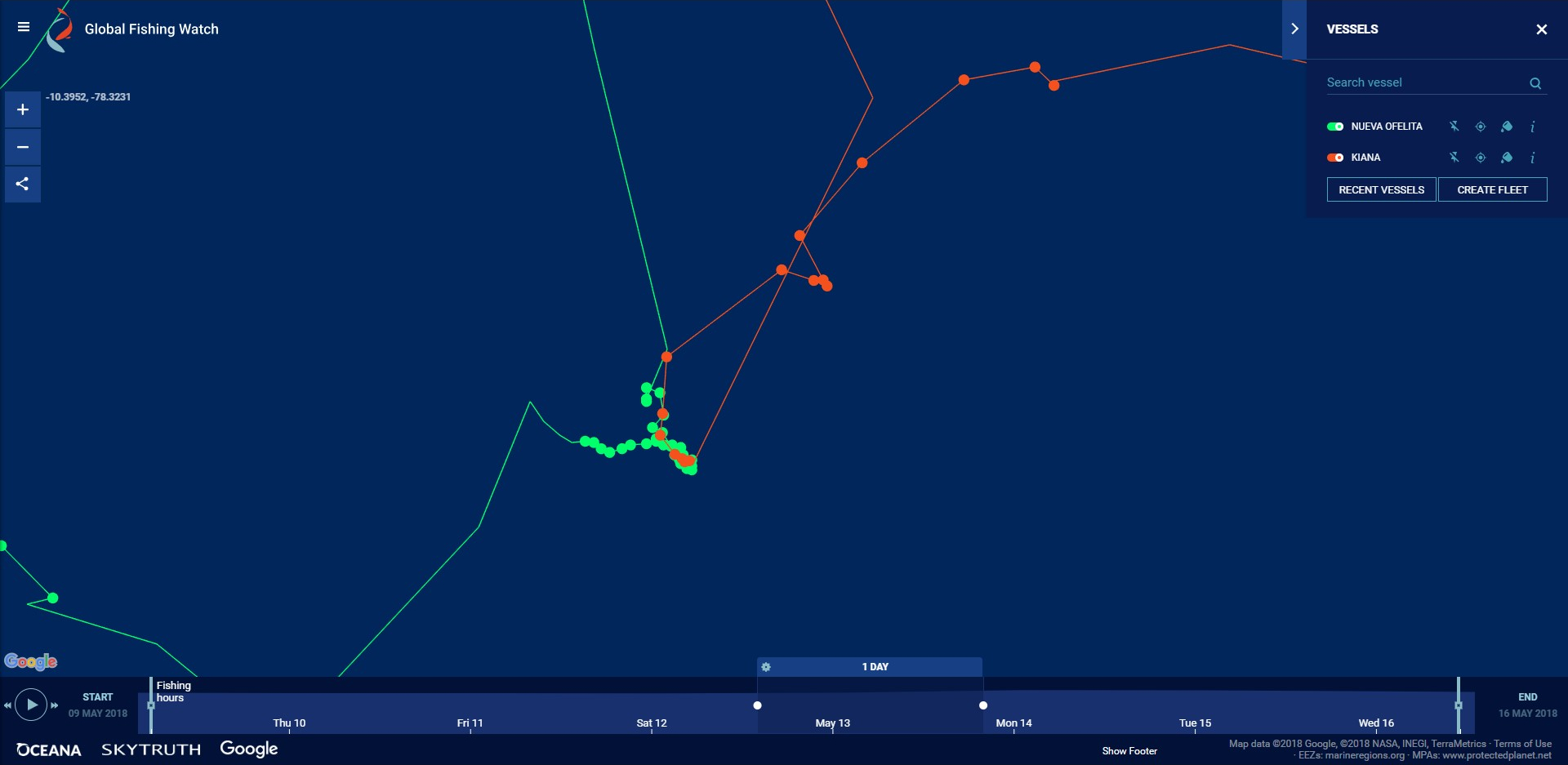

Encounter of two fishing vessels of anchovy during the first season of 2018. Click to view on the map.
The Ministry of Production (PRODUCE) has set the first opening of the 2019 anchovy fishing season for May 4th, with a total catch limit set at 2.1 million metric tons for the north center anchovy stock. About 850 anchovy fishing vessels – 350 industrial vessels and 500 small-scale vessels, will fish for approximately three months. The Ministry of Production, through the Directorate General of Supervision and Control, has the enormous job of monitoring this fleet – with vessels operating across about 30,000 square nautical miles of ocean. The Ministry is responsible for carrying out preventive closures of fishing zones, and monitoring incursions into such zones, along with areas closed to fishing, such as marine protected areas and 5 nautical miles out from the coastline. These restrictions can also be tracked using the Global Fishing Watch platform.
Managing a dynamic fishery
During the anchovy fishing season, the Ministry of Production regularly implements preventive closures of areas due to a high concentration of anchovy in sizes smaller than what is allowed to catch. Fishing zone closures may also be carried out for a period of time, in a determined area, in order to allow the anchovy schools to redistribute or move to other areas.
During the 2018-II fishing season, the government issued 42 communications on preventive closures across 53 fishing areas. One of these, No.115-2018-PRODUCE / DGSFS-PA-SP closed the area between 08°00’S and 08° 30’S from 05 to 20 nautical miles off the Peruvian coast, and for a period of 5 days started on 9 May 2018. The Global Fishing Watch platform shows the dynamic of the behavior of the anchovy fishing fleet during the temporary closure of fishing areas, and how this fleet retreats during these closures (lasting a maximum of 5 days). Once the closure ends, the vessels return to carry out their fishing operations inside the same area. The Global Fishing Watch platform visually demonstrates the great importance of temporary zone closures in the sustainable management of the anchovy fishery.

Transparency central to better governance of our ocean
Global Fishing Watch seeks to promote sustainability and responsible management of our global ocean through greater transparency, offering free satellite tracking data on the world’s commercial fishing activity. We work with governments to combine our data with government systems and publish the fishing vessel information via our public platform, helping to strengthen monitoring and control to combat Illegal, unreported and unregulated (IUU) fishing. If countries publicly share their fishing vessel monitoring data, then we can create a more complete and connected picture of global fishing activity.
The first opening of the 2019 anchovy season marks an important milestone in the collaboration between the Peruvian government and Global Fishing Watch, and the leadership Peru has shown by going public with their vessel tracking data. Global Fishing Watch is committed to supporting Peru as they work to ensure effective monitoring and sustainable management of their important marine resources.
